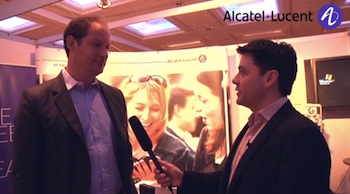A day or so spent at the Global Messaging Congress afforded an opportunity to ask the following questions: what are operators trying to do with their messaging services, and what investments are they making to get there?
Naturally, much of the focus was on what is being termed Next Generation messaging, or IP messaging, or RCS-e to some people, or plain old "combating the OTTs" to others.
Madan Jagernauth, VP Marketing and Strategy of Mavenir, which has just launched a cloud messaging suite, said that there's now no doubt that OTT services are cannibalising MSM revenues, and that the operator response to that has to be to provide a better service of their own. For many, that means RCS-e.
RCS-e has become a bit of a dirty word for many, because of the perceived delay in bringing this standards-based, interoperable technology to market. Florent Stroppa, Principal Product Manager at Vodafone, was having none of that talk, however. He said that in fact, bringing a service to market in 18 months, as two Spanish operators have just done, since the standard was effectively re-started is far from a delay. In fact, it's very quick.
"RCS-e started 18 months ago. RCS was parked, and we didn't really care about that any more. RCS-e has only been around for 18 months, and it's not that long."
Interestingly, Stroppa's view is that RCS-e will enable operators to disrupt the disruptors. His vision of RCS-e is that it will enable telecoms operators to inject comms-type services – chat, voice, video – into other apps. For instance, chat or video could be added into a customer service app. Or the ability to share information, or move to a voice call, within an app would allow developers to add communications to their apps, crucially "without maintaining a communications service backend."
"There's nothing that provides this kind of technology within OTT. If we fail, there will be no-one doing this, so it's really up to the industry to provide these kinds of services" Stroppa said. (Although perhaps someone should point Stroppa in the direction of Twilio he is quite so confident that only the telcos can inject comms services into apps)
This provides a crucial answer to the question: how will operators differentiate in RCS-e – when they're all providing the same sort of interoperable services? By moving to RCS-e as a service, rather than seeing it as an app in itself, operators have the opportunity to become the intelligent pipe that actually adds value.
To that end, Stroppa was pretty clear on what he thinks of Joyn, the GSMA's designated brand for RCS-e type services. "Joyn is irrelevant," he said. He later tempered that by saying that Joyn will be irrelevant in the long term, only serving a useful purpose in the short term as a useful moniker for the sort of rich commas functionality it provides, creating a network effect in the beginning.
But he was pretty clear: "We don't care about apps, we care about services. SMS doesn't have a brand, MMS doesn't have a brand." In other words, Vodafone is not interested in having a Joyn messaging brand on its phone. Instead, it wants to see RCS-e employed to provide capability discovery in the network and the device. A user will have his messaging app, and that will be supported by the ability to discover network conditions, device capabilities, and presence as a capability. (He doesn't see presence as a shared item, either, with users advertising their presence through the messaging app. "You don't share the fact you're online, you're always online," he said. "You'll soon have a messaging app that will use SMS for most cases, and use RCS-e for capability discovery," he concluded.)
And another thing – Stroppa was pretty blunt about so-called innovation in RCS-e. In terms of the feature set, he said, there is none. ICQ did all the feature set innovation a decade ago. "ICQ really invented chat, it invented presence, IM, group chat, file sharing. Let's get everything in perspective, innovation is in the experience space, not in the feature set," he said.
Joyn, Stroppa said, is mainly about the ability to provide a better service for voice; about the ability to add video to calling, providing a very good user experience by removing barriers to action. 3G video calling was a "nightmare" because you had to know if the other person had a video phone, was on 3G, wanted to do a call – quite aside from network QoS. RCS-e takes care of that, which is what is meant by capability discovery. "In fact we joked that the e in RCS-e stands for edge, because really what we are dong is providing edge to edge service discovery."
Messaging security
The other topic to raise its head was that of security. Sandy Gomo of the GSMA gave a heads-up on the GSMA's Spam Reporting Service (SRS), a service backed by technology from Cloudmark that enables mobile operators to give users a shortcode to report spam. The GSMA's SRS then carries out analysis on the reports, sharing that data with member operators.
Five operators in North America are currently using the service. Gomo said that detection of spam and malicious messages is difficult. "The first thing almost every operator tells us is that they don't have a problem, but our response back is, 'How do you know?'" Gomo said that spammers are becoming increasingly sophisticated. One attack that it picked up on whilst trialling SRS in France had generated 6,000 reports from users, but there were 3,000 variations in the actual content of the message. In other words, the spammers were sending very slight variations of the same message, in order to step round any keyword filtering or similar.
Gomo said that most abuse comes from SIM farms – where spammers buy a whole load of cheap pre-paid SIMs, put them in a box, and spam thousands of messages into the network. The three main types of malicious message are advertising spam, fraudulent messages designed to get the user to call or text and premium number, or to share personal details, and finally messages containing malware or a link to an infected site.
So are there any operators, outside of the USA, using the SRS? Its attraction, says Neil Cook, CTO of Cloudmark, is that it enables operators to gain form a greater pool of shared knowledge, with attack reports being anonymised and data shared amongst participating operators. At the moment, though, there appears to be little take-up outside North America. Many operators run their own reporting services, however.
Cloudmark's Cook said that 33% of all spam is now SMSing – the attempt to full users into revealing personal data which is then sold on. "That's very concerning to operators," he said, "as it's a leak of private data through their network and the services they provide to the customer.
One of the advantages hackers and bad guys have in SMS over email is that the open rates are a lot higher. Consequently spoofers need to send far fewer messages than in email spam, where users are more savvy, and protection systems more rife.
That said, numbers are on the rise. Cook said there are 45million spam SMS sent in Europe every day. The cost of SMS is going down, and Cook says Cloudmark can see a correlation between the availability of cheap bundles of texts, and the amount of spam on a network. Very little spam is now being injected into a network from "dodgy" foreign network connections. Instead the vast bulk is internal, emanating from those SIM boxes.
So what is the incentive for operators to do anything about this and to enter the security as a service world that we have written about before? The first is reputational. Protecting users from spam and attacks makes sense in terms of customer loyalty and satisfaction. There are also advantages in offering controls and protection for parents, for example. At a corporate or premium user level there may even be extra revenues involved, through offering "clean pipe" type service. A third reason, Cook says, is to avoid IP address blacklisting. Many operators have fairly limited allocations of NAT IPs – if Botnet attacks from 3G-connected PCs bring about blacklisting of IP addresses, that could have a "material impact" on their businesses, Cook warns.
Providing a slightly different angle, Telsis' Stewart Kelly said that he is seeing a huge interest from operators in assuring operators' own messaging revenues from revenue leakage cause by things such a grey traffic (where, effectively, an operator terminates SMS traffic without getting paid for it) and falls roaming. Telsis' SMS Firewall catches inbound traffic and analyses it before delivery, he said, providing operators with the means to apply controls and policies to traffic. One of the sessions that got a lot of interest at the Congress was Vodafone New Zealand's presentation on its Safe Driving and Parental Controls service, which is supported by Telsis equipment.
Keith Dyer
Editor
Mobile Europe



 There are new personal clouds that store mobile photos and videos online. iCloud is one of the best known but there are others, such as Google Drive. Gartner published a
There are new personal clouds that store mobile photos and videos online. iCloud is one of the best known but there are others, such as Google Drive. Gartner published a 
